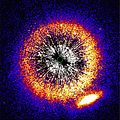File:Viewing the Vermin Galaxy.jpg

Original file (1,244 × 1,242 pixels, file size: 892 KB, MIME type: image/jpeg)
| This is a file from the Wikimedia Commons. Information from its description page there is shown below. Commons is a freely licensed media file repository. You can help. |
Summary
| DescriptionViewing the Vermin Galaxy.jpg |
English: The NASA/ESA Hubble Space Telescope is famous for its jaw-dropping snapshots of the cosmos. At first glance this Picture of the Week appears to be quite the opposite, showing just a blur of jagged spikes, speckled noise, and weird, clashing colours — but once you know what you are looking at, images like this one are no less breathtaking.
This shows a distant galaxy — visible as the smudge to the lower right — as it begins to align with and pass behind a star sitting nearer to us within the Milky Way. This is an event known as a transit. The star is called HD 107146, and it sits at the centre of the frame. Its light has been blocked in this image to make its immediate surroundings and the faint galaxy visible — the position of the star is marked with a green circle. The concentric orange circle surrounding HD 107146 is a circumstellar disc — a disc of debris orbiting the star. In the case of HD 107146 we see the disc face-on. As this star very much resembles our Sun, it is an interesting scientific target to study: its circumstellar disc could be analogous to the asteroids in our Solar System and the Kuiper belt. A detailed study of this system is possible because of the much more distant galaxy — nicknamed the “Vermin Galaxy” by some to reflect their annoyance at its presence — as the star passes in front of it. The unusual pairing was first observed in 2004 by Hubble’s Advanced Camera for Surveys, and again in 2011 by Hubble’s Space Telescope Imaging Spectrograph. The latter image is shown here, as the Vermin Galaxy began its transit behind HD 107146. The galaxy will not be fully obscured until around 2020, but interesting science can be done even while the galaxy is only partly obscured. Light from the galaxy will pass through the star’s debris discs before reaching our telescopes, allowing us to study the properties of the light and how it changes, and thus infer the characteristics of the disc itself. |
| Date | |
| Source | https://www.spacetelescope.org/images/potw1722a/ |
| Author | ESA/Hubble & NASA |
Licensing
| ESA/Hubble images, videos and web texts are released by the ESA under the Creative Commons Attribution 4.0 International license and may on a non-exclusive basis be reproduced without fee provided they are clearly and visibly credited. Detailed conditions are below; see the ESA copyright statement for full information. For images created by NASA or on the hubblesite.org website, or for ESA/Hubble images on the esahubble.org site before 2009, use the {{PD-Hubble}} tag.
Conditions:
Notes:
|
- You are free:
- to share – to copy, distribute and transmit the work
- to remix – to adapt the work
- Under the following conditions:
- attribution – You must give appropriate credit, provide a link to the license, and indicate if changes were made. You may do so in any reasonable manner, but not in any way that suggests the licensor endorses you or your use.
Captions
Items portrayed in this file
depicts
29 May 2017
File history
Click on a date/time to view the file as it appeared at that time.
| Date/Time | Thumbnail | Dimensions | User | Comment | |
|---|---|---|---|---|---|
| current | 21:04, 29 May 2017 |  | 1,244 × 1,242 (892 KB) | Huntster | Use default resolution rather than the stretched screen resolution version. |
| 14:16, 29 May 2017 |  | 1,280 × 1,278 (495 KB) | Jmencisom | User created page with UploadWizard |
File usage
Global file usage
The following other wikis use this file:
Metadata
This file contains additional information, probably added from the digital camera or scanner used to create or digitize it.
If the file has been modified from its original state, some details may not fully reflect the modified file.
| Credit/Provider | ESA/Hubble & NASA |
|---|---|
| Source | ESA/Hubble |
| Short title |
|
| Image title |
|
| Usage terms |
|
| Date and time of data generation | 06:00, 29 May 2017 |
| File change date and time | 11:23, 28 November 2016 |
| Date and time of digitizing | 14:01, 24 November 2016 |
| Date metadata was last modified | 12:23, 28 November 2016 |
| Unique ID of original document | xmp.did:c4ffb57f-57b6-2047-ba9e-b34a0d3db06a |
| Keywords | Vermin Galaxy |
| Contact information |
Karl-Schwarzschild-Strasse 2 Garching bei München, , D-85748 Germany |
| IIM version | 4 |


